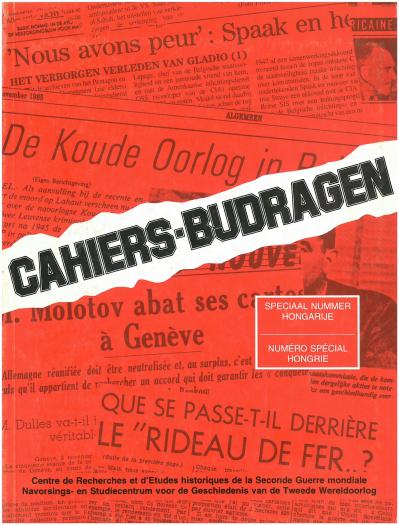The Cold War in the BEG/CHTP (and its predecessor)

The current Journal of Belgian History (Belgisch Tijdschrift voor Nieuwste Geschiedenis/Revue belge d’Histoire contemporaine - JBH/BTNG/RBHC) originated in 2012 from the merger between its eponymous predecessor and the Bijdragen tot de Eigentijds Geschiedenis/Cahiers d'Histoire du Temps présent (BEG/CHTP) which succeeded the Bijdragen tot de Geschiedenis van de Tweede Wereldoorlog/Cahiers d’histoire de la deuxième guerre mondiale in 1997. This page contains a review of articles related to Cold War history published in the BEG/CHTP. A similar review of such publications in the 'old' JBH can be found here. If you look for Cold War-related research in the 'new' JBH you will find it here.
In addition to the BEG/CHTP, why look for publications on the Cold War in its predecessor? One would not immediately expect to find anything on that topic in a journal devoted to the history of World War II. Yet back in 1995 the editors of the Bijdragen/Cahiers devoted an entire issue to Hungary in the early Cold War. This was the result of a colloquium that had brought together Belgian and Hungarian historians in Brussels two years earlier under the title "Two small countries in the Cold War: Belgium and Hungary 1945-1956." The Belgian repercussions of the events in Hungary were dealt with in this special issue by Patrick Claeys (on the trial of Cardinal Mindszenty as reported by the Flemish daily press), Frédérique Werbrouck (on the reactions of public opinion and the political elite to the 1956 Hungarian Uprising) and Frank Caestecker (the impact of the reception of Hungarian refugees on Belgian refugee policy). In turn, Luc De Vos outlined the choices facing Belgian foreign policy in that period (Part 1 / Part 2), while Dirk Martin tried to fathom the Cold War mentality of a top Belgian diplomat.
After the publication of an issue that focused nowhere on WWII, there was perhaps little point in keeping the journal's name, and for the next fifteen years the CegeSoma's house journal went on to live as Bijdragen tot de Eigentijds Geschiedenis/Cahiers d'Histoire du Temps présent (BEG/CHTP). The BEG/CHTP would regularly publish on aspects of the Cold War. Pieter Lagrou led the way in 1997 with an article on how the Cold War shaped the memories of World War II and the European image of the associations of former resistance fighters. In the same issue, Georgi Verbeeck described how old GDR historiography was handled in reunified Germany.
A few years later, Pascal Deloge examined Belgian-British military relations after World War II (7/2000), and Kenneth Bertrams analyzed the issue of U.S. technical assistance in the productivity of Belgian companies in the 1950s (9/2001). Here, however, the Cold War played a role mainly in the background. The same is true of the articles by Paul Wynants (on the Jeunesse Ouvrière Chrétienne in 11/2003), Christoph Brüll (on Belgian-German relations in the late 1940s in CHTP 16/2005 and 23/2011), Nancy Delhalle (on Belgian Francophone theater in the 1970s in 18/2007), Rik Hemmerijckx (on the interaction between student protest and workers' struggles "in the spirit of May 1968" in the same issue) and Eva Schandevyl (on the lawyer Walter Ganshof van der Meersch in 24/2011).
Maarten Van Alstein, on the other hand, put the Cold War at the very center of his doctoral research, one aspect of which appeared in BEG (20/2008). He analyzed the changing mindsets of Belgium's top diplomats at the time of hostile bipolarization in the late 1940s. Indeed, the interaction of ambassadors with the foreign minister and other government members had a significant impact on the positioning of Belgium in the Cold War world order. Although he went much further methodologically, Van Alstein still relied to some extent on older micro-studies about the Cold War thinking of Belgian diplomats, like Dirk Martin's 1995 study.